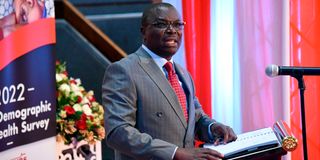The politics of development in the 2022 health survey report

Kenya National Bureau of Statistics Director-General Macdonald Obudho during the launch of the Kenya Demographic and Health Survey 2022 report at KICC in Nairobi on Monday.KNBS data shows that the economy has grown by 5.3 per cent in the first quarter of 2023.
The 2022 Kenya Demographic and Health Survey report released by the Kenya National Bureau of Statistics (KNBS) and the Ministry of Health reveals the good and the ugly of Kenya’s development on matters health 10 years after devolution.
The report provides data to guide planning and implementation of programmes at the national and the county levels. The data should enable the county governments to examine how they have performed in addressing health-related challenges.
However, attention to this report has tended to focus on issues that excite the public rather than what has changed over the years. A close look at the data reveals many problems that should worry county governments and policymakers at the national level.
One key issue of concern is limited uptake of health insurance. It is widely recognised that health insurance reduces healthcare costs, yet only one out of four or about 25 per cent have health insurance.
In the previous 2014 survey, only 18 per cent had health insurance. This means coverage has not expanded in any significant manner. Importantly, the data shows a majority of people with ‘insurance cover’ are relatively wealthy.
Of course the most common health insurance for all is the National Health Insurance Fund (NHIF) cover. This goes for about Sh500 per month for the unemployed and the self-employed but the uptake is still very low.
A lot more people and households should be having the cover given the high costs of treatment in hospitals nowadays. Furthermore, diseases like cancer have become quite common. Treatment is very expensive for some of these diseases, especially if one does not have any health insurance. The failure to improve uptake is an indictment of our policymakers at both levels of government.
The data reveals an increase in the use of skilled providers of maternal care. The proportion of live births that are assisted by skilled providers has increased from 41 per cent in 2003 to 88 per cent in 2022. But this is relatively lower in the marginalised and poor counties of Northern Kenya. It is as low as 53 per cent in Mandera; 55 per cent in Wajir; and 57 per cent in Samburu. It is also low in Tana River at 59 per cent.
Vaccination coverage shows worrying trends too. Although the report shows a sustained upward trend from 2008 in vaccination of children, there are counties where the coverage is as low as you would find in South Sudan and Somalia, our poor neighbours.
The number of children in the 12-23-month age bracket who are vaccinated against basic conditions is as low as 23 per cent in Garissa; 29 per cent in Mandera; 49 per cent in Wajir and West Pokot. This means more than half of the population of children in these counties are being exposed to life-threatening but preventable diseases, putting at risk the future human capital foundation for these counties.
The children who are not vaccinated will certainly have more challenges as they grow up and may not even go to school. Mortality among those under five years is also high in these counties, meaning the human capital index for these counties is already compromised as has been the case from the colonial period.
Equalisation fund
We must judge these figures from the perspective of politics of devolution. Devolution is all about delivering services to improve people’s quality of life and wellbeing in general. We know the challenges the county governments experience in accessing revenue almost every financial year.
We also know that powerful people in both the last five years of the government of President Mwai Kibaki and the first five years of President Uhuru Kenyatta’s government frustrated operationalisation of the equalisation fund – the ‘catch up’ fund for marginalised counties – and the counties continued to lag in basic services. But this should not translate to low levels of skilled maternal care in these counties.
These poor figures indicate that governors in some of the counties have failed to prioritise building of a skilled health workforce. Ten years after devolution, the county governments in the marginalised areas should have addressed these challenges by demanding the resumption of training of community health workers and volunteers. Of course some still think that such low-level skills should not be provided.
The poor vaccination coverage in the counties is an indictment of the national and the county government leadership too. The tension between the two levels over who should handle the vaccination budget and resources is responsible for this mess.
County governments may not have the capacity to roll out vaccination programmes, but they certainly have good facilities that could be equipped to support vaccination on a day-to-day basis. However, in these poor counties, not all facilities are equipped or fit for purpose. The blame for this goes to both the national and county governments. They have a blurred vision for the future of the children in these counties.
These figures reveal deep-seated inequalities in Kenya. While the marginal counties have low figures in terms of vaccination, use of skilled health providers and health insurance, other counties have high figures in all these indicators.
For instance, Vihiga and Kirinyaga are leading in terms of children who are vaccinated for basic antigens; close to 100 per cent of children here are vaccinated while the maringalised counties have less than 50 per cent. The percentage of live births assisted by skilled providers is as high as 99 per cent in Nyeri; and 98 per cent in Nyandarua. It is as high as 92 per cent in Makueni and 95 per cent in Uasin Gishu.
These differences raise the need for a national conversation on how to address a fundamental aspect of human capital development in Kenya – healthcare – especially in these marginalised counties. Failure to address delivery of health services in these counties will certainly weaken the foundation of human capital across the country.
This is precisely because national development is the sum total of development in each of the 47 counties. Failure to address challenges in these counties will have spillover effects in other counties too. The earlier we begin addressing the challenges to development in these counties the better for the country. But this is a conversation that the ethnicised national elite would not like to hear.
Prof Kanyinga is based at the Institute for Development Studies (IDS), University of Nairobi, [email protected], @karutikk;





